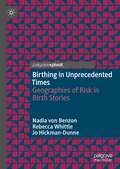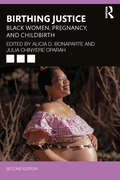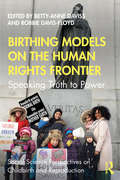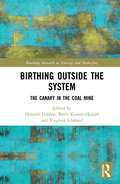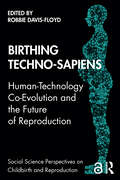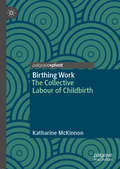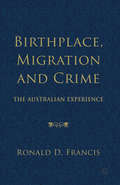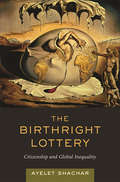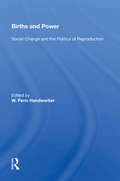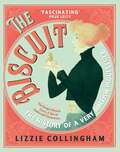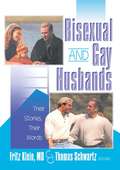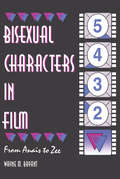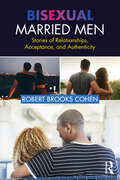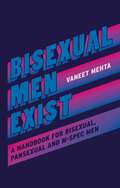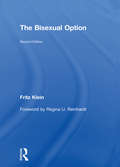- Table View
- List View
Birthing in Unprecedented Times: Geographies of Risk in Birth Stories
by Nadia von Benzon Rebecca Whittle Jo Hickman-DunneThis book shines a light on the way in which risk – in and beyond childbirth – is highly contextual, and the way in which risk-management strategies can be understood as socially and materially constructed.
Birthing Justice: Black Women, Pregnancy, and Childbirth
by Alicia D. Bonaparte Julia Chinyere OparahThe second edition of this pathbreaking, widely taught book offers six new chapters, on breastfeeding and Black infant health; Black birthing during COVID; Black doulas rethinking birthing practices; the recent buildup of a US national movement; childbirth in Zanzibar; and expanding the global movement for sexual and reproductive well-being. Other chapters are updated throughout. Birthing Justice puts Black women’s voices at the center of the debate on what should be done to fix the broken maternal care system. It foregrounds Black women’s agency in the birth justice movement. First published in 2016, Birthing Justice is a seminal text for those interested in maternal healthcare, reproductive justice, health equity, and intersectional racial justice, especially in courses on gender studies, Black studies, public health, and training programs for midwives and OB/GYNs.
Birthing Justice: Black Women, Pregnancy, and Childbirth
The second edition of this pathbreaking, widely taught book offers six new chapters, on breastfeeding and Black infant health; Black birthing during COVID; Black doulas rethinking birthing practices; the recent buildup of a US national movement; childbirth in Zanzibar; and expanding the global movement for sexual and reproductive well-being. Other chapters are updated throughout. Birthing Justice puts Black women’s voices at the center of the debate on what should be done to fix the broken maternal care system. It foregrounds Black women’s agency in the birth justice movement. First published in 2016, Birthing Justice is a seminal text for those interested in maternal healthcare, reproductive justice, health equity, and intersectional racial justice, especially in courses on gender studies, Black studies, public health, and training programs for midwives and OB/GYNs.
Birthing Models on the Human Rights Frontier: Speaking Truth to Power (Social Science Perspectives on Childbirth and Reproduction)
by Betty-Anne Daviss; Robbie Davis-FloydThis book addresses the politics of global health and social justice issues around birth, focusing on dynamic communities that have chosen to speak truth to power by reforming dysfunctional health care systems or creating new ones outside the box. The chapters present models of childbirth at extreme ends of a spectrum—from the conflict zones and disaster areas of Afghanistan, Israel, Palestine, and Indonesia, to high-risk tertiary care settings in China, Canada, Australia, and Turkey. Debunking notions about best care, the volume illustrates how human rights in health care are on a collision course with global capitalism and offers a number of specific solutions to this ever-increasing problem. This volume will be a valuable resource for scholars and students in anthropology, sociology, health, and midwifery, as well as for practitioners, policy makers, and organizations focused on birth or on social activism in any arena.
Birthing Models on the Human Rights Frontier: Speaking Truth to Power (Social Science Perspectives on Childbirth and Reproduction)
by Betty-Anne Daviss Robbie Davis-FloydThis book addresses the politics of global health and social justice issues around birth, focusing on dynamic communities that have chosen to speak truth to power by reforming dysfunctional health care systems or creating new ones outside the box. The chapters present models of childbirth at extreme ends of a spectrum—from the conflict zones and disaster areas of Afghanistan, Israel, Palestine, and Indonesia, to high-risk tertiary care settings in China, Canada, Australia, and Turkey. Debunking notions about best care, the volume illustrates how human rights in health care are on a collision course with global capitalism and offers a number of specific solutions to this ever-increasing problem. This volume will be a valuable resource for scholars and students in anthropology, sociology, health, and midwifery, as well as for practitioners, policy makers, and organizations focused on birth or on social activism in any arena.
Birthing Outside the System: The Canary in the Coal Mine (Routledge Research in Nursing and Midwifery)
by Hannah Dahlen Bashi Hazard Virginia SchmiedThis book investigates why women choose ‘birth outside the system’ and makes connections between women’s right to choose where they birth and violations of human rights within maternity care systems. Choosing to birth at home can force women out of mainstream maternity care, despite research supporting the safety of this option for low-risk women attended by midwives. When homebirth is not supported as a birthplace option, women will defy mainstream medical advice, and if a midwife is not available, choose either an unregulated careprovider or birth without assistance. This book examines the circumstances and drivers behind why women nevertheless choose homebirth by bringing legal and ethical perspectives together with the latest research on high-risk homebirth (breech and twin births), freebirth, birth with unregulated careproviders and the oppression of midwives who support unorthodox choices. Stories from women who have pursued alternatives in Australia, Europe, Russia, the UK, the US, Canada, the Middle East and India are woven through the research. Insight and practical strategies are shared by doctors, midwives, lawyers, anthropologists, sociologists and psychologists on how to manage the tension between professional obligations and women’s right to bodily autonomy. This book, the first of its kind, is an important contribution to considerations of place of birth and human rights in childbirth.
Birthing Outside the System: The Canary in the Coal Mine (Routledge Research in Nursing and Midwifery)
by Dahlen Hannah Kumar-Hazard Bashi Virginia SchmiedThis book investigates why women choose ‘birth outside the system’ and makes connections between women’s right to choose where they birth and violations of human rights within maternity care systems. Choosing to birth at home can force women out of mainstream maternity care, despite research supporting the safety of this option for low-risk women attended by midwives. When homebirth is not supported as a birthplace option, women will defy mainstream medical advice, and if a midwife is not available, choose either an unregulated careprovider or birth without assistance. This book examines the circumstances and drivers behind why women nevertheless choose homebirth by bringing legal and ethical perspectives together with the latest research on high-risk homebirth (breech and twin births), freebirth, birth with unregulated careproviders and the oppression of midwives who support unorthodox choices. Stories from women who have pursued alternatives in Australia, Europe, Russia, the UK, the US, Canada, the Middle East and India are woven through the research. Insight and practical strategies are shared by doctors, midwives, lawyers, anthropologists, sociologists and psychologists on how to manage the tension between professional obligations and women’s right to bodily autonomy. This book, the first of its kind, is an important contribution to considerations of place of birth and human rights in childbirth.
Birthing Techno-Sapiens: Human-Technology Co-Evolution and the Future of Reproduction (Social Science Perspectives on Childbirth and Reproduction)
by Robbie Davis-FloydThis ground-breaking book challenges us to re-think ourselves as techno-sapiens—a new species we are creating as we continually co-evolve ourselves with our technologies. While some of its chapters are imaginary, they are all empirically grounded in ethnography and richly theorized from diverse disciplines. The authors go far beyond a techno-optimism vs. techno-pessimism stance, stretching our thinking about birthing techno-sapiens to consider not only how our cyborgian reproductive lives are constrained and/or enabled by technology but are also about emotions and spirit. The world of reproductive health care and particularly that of genetic engineering is developing exponentially, and current challenges are vastly different from those of a decade ago. The book is provocative, intended to generate debate, ideas, and future research and to influence ethical policy and practice in human techno-reproduction. It will be of interest across the social sciences and humanities, for reproductive scholars, bioethicists, techno-scientists, and those involved in the development and delivery of maternity services.
Birthing Techno-Sapiens: Human-Technology Co-Evolution and the Future of Reproduction (Social Science Perspectives on Childbirth and Reproduction)
by Robbie Davis-FloydThis ground-breaking book challenges us to re-think ourselves as techno-sapiens—a new species we are creating as we continually co-evolve ourselves with our technologies. While some of its chapters are imaginary, they are all empirically grounded in ethnography and richly theorized from diverse disciplines. The authors go far beyond a techno-optimism vs. techno-pessimism stance, stretching our thinking about birthing techno-sapiens to consider not only how our cyborgian reproductive lives are constrained and/or enabled by technology but are also about emotions and spirit. The world of reproductive health care and particularly that of genetic engineering is developing exponentially, and current challenges are vastly different from those of a decade ago. The book is provocative, intended to generate debate, ideas, and future research and to influence ethical policy and practice in human techno-reproduction. It will be of interest across the social sciences and humanities, for reproductive scholars, bioethicists, techno-scientists, and those involved in the development and delivery of maternity services.
Birthing Work: The Collective Labour of Childbirth
by Katharine McKinnonThis book traces the assemblage that comes into being in the spaces and experiences of childbirth. Charting the contributions of the multiple human and non-human actors that contribute to the birth experience, it offers a new perspective on childbirth that cuts across the often emotional debates about natural versus medicalised birth. Drawing on ethnographic interviews with mothers, midwives and obstetricians, it provides an insight into the collective endeavours that shape birth. In doing so, it also explores who does the work of childbirth, expanding the boundaries for who (and what) is responsible for this collective labour and highlighting the interdependencies that characterise it. Structured around eight chapters that each focus on a different actor in the birth space, the volume argues that pregnancy and childbearing brings us into new relationships: with ourselves, with the child to be born, our partners and families, those who care for us, and with more-than-human others.
Birthplace, Migration and Crime: The Australian Experience
by Ronald D. FrancisAn historical and contemporary account of migrant crime in Australia, this book explores a range of issues from mental health and victimology to immigration policy and legal analysis, arguing that it is birthplace, not race, which impacts upon crimes committed by migrants.
The Birthright Lottery: Citizenship and Global Inequality
by Ayelet ShacharThe vast majority of the global population acquires citizenship purely by accidental circumstances of birth. In The Birthright Lottery, Ayelet Shachar argues that birthright citizenship in an affluent society can be thought of as a form of property inheritance: that is, a valuable entitlement transmitted by law to a restricted group of recipients under conditions that perpetuate the transfer of this prerogative to their heirs.
Births And Power: Social Change And The Politics Of Reproduction
by W. Penn HandwerkerThis book challenges orthodox public perspectives on reproduction. It relies on participant observation, field censuses, interviews, and use of official demographic, epidemiological, and health statistics.
Births And Power: Social Change And The Politics Of Reproduction
by W. Penn HandwerkerThis book challenges orthodox public perspectives on reproduction. It relies on participant observation, field censuses, interviews, and use of official demographic, epidemiological, and health statistics.
The Biscuit: The History of a Very British Indulgence
by Lizzie CollinghamBourbons. Custard Creams. Rich Tea. Jammie Dodgers. Chocolate Digestives. Shortbread. Ginger snaps. Which is your favourite?British people eat more biscuits than any other nation; they are as embedded in our culture as fish and chips or the Sunday roast. But biscuits are not only tasty treats to go with a cup of tea, the sustenance they afford is often emotional, evoking nostalgic memories of childhood.Lizzie Collingham begins in Roman times when biscuits – literally, ‘twice-baked’ bread – became the staple of the poor; she takes us to the Middle East, where the addition of sugar to the dough created the art of confectionery. Yet it was in Britain that bakers experimented to create the huge variety of biscuits which populate our world today. And when the Industrial Revolution led to their mass production, biscuits became integral to the British diet. We follow the humble biscuit’s transformation from durable staple for sailors, explorers and colonists to sweet luxury for the middling classes to comfort food for an entire nation. Like an assorted tin of biscuits, this charming and beautifully illustrated book has something to offer for everyone, combining recipes for hardtack and macaroons, Shrewsbury biscuits and Garibaldis, with entertaining and eye-opening vignettes of social history.
Bisexual and Gay Husbands: Their Stories, Their Words
by Fritz Klein Thomas R SchwartzWhat happens when married men face their gay/bisexual needs?This astonishing volume offers an intimate look into the lives and thoughts of bisexual men. Already married to women, these men are undeniably attracted to other men. Their struggle with conflicting needs, desires, and loyalties is not filtered through theories or evoked in brief interviews. It comes straight from their own keyboards. The stories told in Bisexual and Gay Husbands are taken from an Internet mailing list, which allows people to speak freely and in anonymity, yet also encourages the development of a tightly knit community. Men at all stages of the coming-out process share their experiences, their secrets, their pain, shame, anger, and hope.One man writes, “I have found the answer to my bisexual needs and am afraid to embrace it. I need help and advice to know what to do. What you people have done in your lives may hold the key to helping me decide on a course of action. I am either going to create a dream come true or hell on earth as I destroy my marriage. I can&’t tell which, and of course you can&’t either. But you CAN tell me how you are handling the problems I am facing.”Bisexual and Gay Husbands includes advice and information on the issues that touch these men most deeply, including: how do I tell my wife and kids? what does it mean to self-identify as bisexual or gay? what kinds of relationships do I want with men? can triads work? how do I deal with my children&’s reaction? do I have to leave my wife?The insight, intelligence, and honesty revealed in Bisexual and Gay Husbands make it a riveting read, but it also has great clinical and historic value for therapists, sex theorists, and bisexual men and their families.
Bisexual and Gay Husbands: Their Stories, Their Words
by Fritz Klein Thomas R SchwartzWhat happens when married men face their gay/bisexual needs?This astonishing volume offers an intimate look into the lives and thoughts of bisexual men. Already married to women, these men are undeniably attracted to other men. Their struggle with conflicting needs, desires, and loyalties is not filtered through theories or evoked in brief interviews. It comes straight from their own keyboards. The stories told in Bisexual and Gay Husbands are taken from an Internet mailing list, which allows people to speak freely and in anonymity, yet also encourages the development of a tightly knit community. Men at all stages of the coming-out process share their experiences, their secrets, their pain, shame, anger, and hope.One man writes, “I have found the answer to my bisexual needs and am afraid to embrace it. I need help and advice to know what to do. What you people have done in your lives may hold the key to helping me decide on a course of action. I am either going to create a dream come true or hell on earth as I destroy my marriage. I can&’t tell which, and of course you can&’t either. But you CAN tell me how you are handling the problems I am facing.”Bisexual and Gay Husbands includes advice and information on the issues that touch these men most deeply, including: how do I tell my wife and kids? what does it mean to self-identify as bisexual or gay? what kinds of relationships do I want with men? can triads work? how do I deal with my children&’s reaction? do I have to leave my wife?The insight, intelligence, and honesty revealed in Bisexual and Gay Husbands make it a riveting read, but it also has great clinical and historic value for therapists, sex theorists, and bisexual men and their families.
Bisexual Characters in Film: From Ana's to Zee
by Wayne M BryantHow far have we progressed from the days when showing a film such as Jack Smith’s Flaming Creatures landed the cinema’s programmer, projectionist, and ticket taker in jail? What are some of the hidden clues modern audiences are overlooking in older films that suggest a character’s bisexuality? Which famous actors, actresses, directors, and screenwriters were attracted to people of both sexes? In Bisexual Characters in Film, the first book to focus on the role of bisexual characters in film, you’ll find answers to these questions and many more as you explore, analyze, and celebrate 80 years of bisexual movie characters (and the people who have created them) from around the world. A lively, entertaining, and informative commentary, this book examines the treatment of bisexual film characters and shows you how that treatment has been affected by societal forces such as censorship, politics, religious prejudices, homophobia, and sexual stereotypes. Bisexual Characters in Film looks at the contribution of bisexual people (and others who have had lovers of varying sexes) to the body of work available on film today. These include the directors, writers, actors, composers, and designers whose sexual orientation has informed their work. An analysis of the Motion Picture Production Code and its devastating effect on bisexual and homosexual screen images forms an important part of the book. You learn how, specifically, it eradicated gay, lesbian, and bisexual characters from Hollywood films as well as the role of bisexual, lesbian, and gay filmmakers in finally defeating it. Other questions you’ll find answers to include: Who, or what, is a bisexual? How were bisexual characters represented in silent film, before the forces of censorship banned them from the screen? What bisexual myths and stereotypes are portrayed on film? What is the role of “camp” in bisexual film?Bisexual Characters in Film is a unique resource for researchers; librarians; film festival planners; the queer media; professors and students of lesbian, gay, and bisexual studies; bisexual activists; and general bisexual, gay, lesbian, and transgendered readers. It provides a much-needed view of bisexual representations in a major segment of our popular culture.
Bisexual Characters in Film: From Ana's to Zee
by Wayne M BryantHow far have we progressed from the days when showing a film such as Jack Smith’s Flaming Creatures landed the cinema’s programmer, projectionist, and ticket taker in jail? What are some of the hidden clues modern audiences are overlooking in older films that suggest a character’s bisexuality? Which famous actors, actresses, directors, and screenwriters were attracted to people of both sexes? In Bisexual Characters in Film, the first book to focus on the role of bisexual characters in film, you’ll find answers to these questions and many more as you explore, analyze, and celebrate 80 years of bisexual movie characters (and the people who have created them) from around the world. A lively, entertaining, and informative commentary, this book examines the treatment of bisexual film characters and shows you how that treatment has been affected by societal forces such as censorship, politics, religious prejudices, homophobia, and sexual stereotypes. Bisexual Characters in Film looks at the contribution of bisexual people (and others who have had lovers of varying sexes) to the body of work available on film today. These include the directors, writers, actors, composers, and designers whose sexual orientation has informed their work. An analysis of the Motion Picture Production Code and its devastating effect on bisexual and homosexual screen images forms an important part of the book. You learn how, specifically, it eradicated gay, lesbian, and bisexual characters from Hollywood films as well as the role of bisexual, lesbian, and gay filmmakers in finally defeating it. Other questions you’ll find answers to include: Who, or what, is a bisexual? How were bisexual characters represented in silent film, before the forces of censorship banned them from the screen? What bisexual myths and stereotypes are portrayed on film? What is the role of “camp” in bisexual film?Bisexual Characters in Film is a unique resource for researchers; librarians; film festival planners; the queer media; professors and students of lesbian, gay, and bisexual studies; bisexual activists; and general bisexual, gay, lesbian, and transgendered readers. It provides a much-needed view of bisexual representations in a major segment of our popular culture.
Bisexual Married Men: Stories of Relationships, Acceptance, and Authenticity
by Robert Brooks CohenHow much do you know about the lives of bisexual men who are married to women? Do you know any personally? Have you seen them represented in the media or pop culture? Bisexual people make up a majority of the LGBT+ community, but they are still relatively hidden and misunderstood. Robert Brooks Cohen aims to address this invisibility by sharing a collection of interviews with Bi+ men who are or were married to women, helping readers find connection, understanding, and community. Their experience is often erased as "not queer enough", but these men are queer, and they are challenging societal norms in important and innovative ways. Written by the host of 'Two Bi Guys', this book intersperses Robert's bisexual journey with the diverse stories of other Bi+ men to help normalize sexual fluidity and create more awareness and compassion. Each chapter is framed around a bisexual married man's story which touches on an important theme in many people's journey, such as coming out, monogamy, intersectionality, porn, marriage, parenting, and finding community, with Robert sharing his thoughts, research, and analysis. This book shares interviews with men and a few of their wives from a wide array of cultural and regional backgrounds, religious family structures, and more, helping bisexual men find pride, validation, and joy in their sexual identity. This book is written about and for bisexual and questioning men so they can see their experience represented. However, it is also for their partners, family, and friends - as well as students, researchers, clinicians with bisexual clients, and allies - so that they can better understand the unique challenges of this identity and provide meaningful support.
Bisexual Married Men: Stories of Relationships, Acceptance, and Authenticity
by Robert Brooks CohenHow much do you know about the lives of bisexual men who are married to women? Do you know any personally? Have you seen them represented in the media or pop culture? Bisexual people make up a majority of the LGBT+ community, but they are still relatively hidden and misunderstood. Robert Brooks Cohen aims to address this invisibility by sharing a collection of interviews with Bi+ men who are or were married to women, helping readers find connection, understanding, and community. Their experience is often erased as "not queer enough", but these men are queer, and they are challenging societal norms in important and innovative ways. Written by the host of 'Two Bi Guys', this book intersperses Robert's bisexual journey with the diverse stories of other Bi+ men to help normalize sexual fluidity and create more awareness and compassion. Each chapter is framed around a bisexual married man's story which touches on an important theme in many people's journey, such as coming out, monogamy, intersectionality, porn, marriage, parenting, and finding community, with Robert sharing his thoughts, research, and analysis. This book shares interviews with men and a few of their wives from a wide array of cultural and regional backgrounds, religious family structures, and more, helping bisexual men find pride, validation, and joy in their sexual identity. This book is written about and for bisexual and questioning men so they can see their experience represented. However, it is also for their partners, family, and friends - as well as students, researchers, clinicians with bisexual clients, and allies - so that they can better understand the unique challenges of this identity and provide meaningful support.
Bisexual Men Exist: A Handbook for Bisexual, Pansexual and M-Spec Men
by Vaneet Mehta"You're just being greedy.""Are you sure you're not gay?""Pick a side."Being a bisexual man isn't easy - something Vaneet Mehta knows all too well. After spending more than a decade figuring out his identity, Vaneet's coming out was met with questioning, ridicule and erasure. This experience inspired Vaneet to create the viral #BisexualMenExist campaign, combatting the hate and scepticism m-spec (multi-gender attracted spectrum) men encounter, and helping others who felt similarly alone and trapped. This powerful book is an extension of that fight. Navigating a range of topics, including coming out, dating, relationships and health, Vaneet shares his own lived experience as well as personal stories from others in the community to help validate and uplift other bisexual men. Discussing the treatment of m-spec men in LGBTQ+ places, breaking down stereotypes and highlighting the importance of representation and education, this empowering book is a rallying call for m-spec men everywhere.
Bisexual Men Exist: A Handbook for Bisexual, Pansexual and M-Spec Men
by Vaneet Mehta"You're just being greedy.""Are you sure you're not gay?""Pick a side."Being a bisexual man isn't easy - something Vaneet Mehta knows all too well. After spending more than a decade figuring out his identity, Vaneet's coming out was met with questioning, ridicule and erasure. This experience inspired Vaneet to create the viral #BisexualMenExist campaign, combatting the hate and scepticism m-spec (multi-gender attracted spectrum) men encounter, and helping others who felt similarly alone and trapped. This powerful book is an extension of that fight. Navigating a range of topics, including coming out, dating, relationships and health, Vaneet shares his own lived experience as well as personal stories from others in the community to help validate and uplift other bisexual men. Discussing the treatment of m-spec men in LGBTQ+ places, breaking down stereotypes and highlighting the importance of representation and education, this empowering book is a rallying call for m-spec men everywhere.
The Bisexual Option: Second Edition
by Fritz KleinSoon to be translated into Japanese! The Bisexual Option explores bisexuality, explains the bisexual, and explodes myths surrounding this large “unseen” segment of the population. Now in its second edition, this intriguing book gives an overview of bisexuality. As there is still no book that covers the subject like this one, it is must reading for establishing a contemporary view of bisexuality and those committed to a bisexual lifestyle. Fritz Klein, an experienced psychiatrist and expert in bisexuality and sexual orientation, explains the concept and the variables of sexual orientation and where bisexuality fits.He covers many subjects in the book including: myths of bisexual nonexistence and the “either/or” dilemma intimacy, both emotional and sexual an explanation of bisexuality and the Oedipus Complex definitions and examples of the healthy and troubled bisexual major sociological findings about bisexuality the bisexual in history the bisexual as depicted in the arts factors that will influence bisexuality in the futureThe book helps readers understand where they fit on the sexual orientation continuum. The Bisexual Option aids in explaining who bisexuals are and why they have problems in heterosexual as well as homosexual societies and shows bisexuals that they are not alone. Even helping professionals will find information on this “invisible” but large segment of the population.A variety of readers will want to read The Bisexual Option including the bisexual community and individual bisexuals, the homosexual communities which include many bisexuals, mental health practitioners, psychologists, both students and professionals, university students, married partners of bisexuals, HIV/AIDS workers who wish to become acquainted with how bisexuality affects the risk to the heterosexual community, sexologists, and researchers.
The Bisexual Option: Second Edition
by Fritz KleinSoon to be translated into Japanese! The Bisexual Option explores bisexuality, explains the bisexual, and explodes myths surrounding this large “unseen” segment of the population. Now in its second edition, this intriguing book gives an overview of bisexuality. As there is still no book that covers the subject like this one, it is must reading for establishing a contemporary view of bisexuality and those committed to a bisexual lifestyle. Fritz Klein, an experienced psychiatrist and expert in bisexuality and sexual orientation, explains the concept and the variables of sexual orientation and where bisexuality fits.He covers many subjects in the book including: myths of bisexual nonexistence and the “either/or” dilemma intimacy, both emotional and sexual an explanation of bisexuality and the Oedipus Complex definitions and examples of the healthy and troubled bisexual major sociological findings about bisexuality the bisexual in history the bisexual as depicted in the arts factors that will influence bisexuality in the futureThe book helps readers understand where they fit on the sexual orientation continuum. The Bisexual Option aids in explaining who bisexuals are and why they have problems in heterosexual as well as homosexual societies and shows bisexuals that they are not alone. Even helping professionals will find information on this “invisible” but large segment of the population.A variety of readers will want to read The Bisexual Option including the bisexual community and individual bisexuals, the homosexual communities which include many bisexuals, mental health practitioners, psychologists, both students and professionals, university students, married partners of bisexuals, HIV/AIDS workers who wish to become acquainted with how bisexuality affects the risk to the heterosexual community, sexologists, and researchers.
